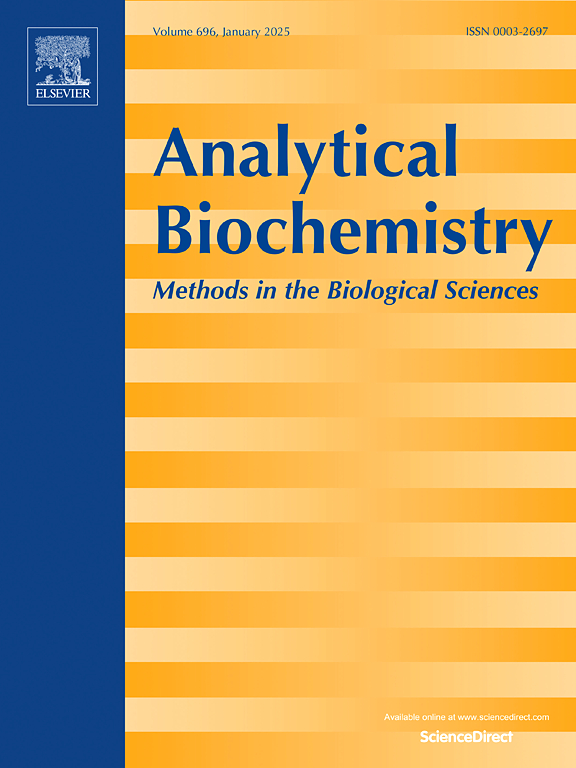Development of a chemiluminescence enzyme immunoassay (CLEIA) for quantitating L1 protein in HPV vaccines
IF 2.5
4区 生物学
Q2 BIOCHEMICAL RESEARCH METHODS
引用次数: 0
Abstract
The L1 protein serves as the principal capsid component of human papillomavirus (HPV). All globally commercialized HPV vaccines utilize virus-like particles (VLPs) formed through L1 protein self-assembly. Quantitative analysis of L1 protein concentration constitutes a critical parameter for evaluating the antigenic potency of HPV vaccines. In this study, we developed a chemiluminescent enzyme immunoassay (CLEIA) for precise quantification of L1 protein in bivalent HPV vaccines. Employing a sandwich immunoassay format, antigen-antibody complexes were immobilized on 96-well microplates using capture antibodies, followed by detection with HRP-conjugated secondary antibodies. Chemiluminescent signal amplification was achieved through enzymatic catalysis of luminol/hydrogen peroxide in the presence of enhancer molecules. Systematic optimization of experimental parameters yielded a validated methodology demonstrating excellent reproducibility (inter-assay CV < 4 %), accuracy (recovery rate 100.5 ± 2.8 % for 16L1 and 95.5 ± 6.4 % for 18L1), precision (inter-assay CV < 7 %) and sensitivity (limit of quantitation (LOQ) 0.0996 μg/mL for HPV16L1 and 0.1459 μg/mL for HPV18L1). This optimized assay provides a reliable analytical platform for quantitating L1 Protein in bivalent HPV vaccine.

建立一种化学发光酶免疫分析法(CLEIA)定量HPV疫苗中L1蛋白
L1蛋白是人乳头瘤病毒(HPV)的主要衣壳成分。所有全球商业化的HPV疫苗都利用通过L1蛋白自组装形成的病毒样颗粒(vlp)。L1蛋白浓度的定量分析是评价HPV疫苗抗原性的关键参数。在这项研究中,我们开发了一种化学发光酶免疫分析法(CLEIA),用于精确定量二价HPV疫苗中的L1蛋白。采用夹心免疫测定法,将抗原-抗体复合物固定在96孔微孔板上,使用捕获抗体,然后用酶标二抗检测。化学发光信号的放大是通过在增强剂分子存在下的鲁米诺/过氧化氢酶催化实现的。实验参数的系统优化产生了一种经过验证的方法,具有出色的重复性(测定间CV <;准确度(16L1的回收率为100.5±2.8%,18L1的回收率为95.5±6.4%),精密度(测定间CV <;HPV16L1的定量限为0.0996 μg/mL, HPV18L1的定量限为0.1459 μg/mL。该优化方法为二价HPV疫苗L1蛋白的定量分析提供了可靠的分析平台。
本文章由计算机程序翻译,如有差异,请以英文原文为准。
求助全文
约1分钟内获得全文
求助全文
来源期刊

Analytical biochemistry
生物-分析化学
CiteScore
5.70
自引率
0.00%
发文量
283
审稿时长
44 days
期刊介绍:
The journal''s title Analytical Biochemistry: Methods in the Biological Sciences declares its broad scope: methods for the basic biological sciences that include biochemistry, molecular genetics, cell biology, proteomics, immunology, bioinformatics and wherever the frontiers of research take the field.
The emphasis is on methods from the strictly analytical to the more preparative that would include novel approaches to protein purification as well as improvements in cell and organ culture. The actual techniques are equally inclusive ranging from aptamers to zymology.
The journal has been particularly active in:
-Analytical techniques for biological molecules-
Aptamer selection and utilization-
Biosensors-
Chromatography-
Cloning, sequencing and mutagenesis-
Electrochemical methods-
Electrophoresis-
Enzyme characterization methods-
Immunological approaches-
Mass spectrometry of proteins and nucleic acids-
Metabolomics-
Nano level techniques-
Optical spectroscopy in all its forms.
The journal is reluctant to include most drug and strictly clinical studies as there are more suitable publication platforms for these types of papers.
 求助内容:
求助内容: 应助结果提醒方式:
应助结果提醒方式:


